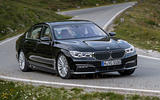What is it?
The 740Le XDrive is probably best described as one of BMW’s mightiest technical achievements to date. It takes the new ‘carbon-core’ 7 Series and adds an electric hybrid drivetrain and a 7kWh battery pack to the technical mix. This range-topping long-wheelbase variant also gets permanent four-wheel drive.
The drivetrain is based around a 2.0-litre, four-cylinder 'Twinpower' turbocharged petrol engine, which has been boosted to produce peaks of 265bhp and 295lb ft, incidentally making it the most powerful four-cylinder petrol engine ever used in a series-production BMW. This drives an eight-speed Steptronic automatic transmission, which is also fitted with a 111bhp electric motor. This motor also develops a healthy 184lb ft from start-up and acts as a generator, particularly when the driver is braking, to help top up the battery pack. The transmission also features a power take-off, sending drive to the car’s front wheels. Four-wheel drive is permanently engaged.
A lithium ion battery pack sits inside a bespoke cast aluminium casing and is mounted under the rear seats and cooled by a feed from the car’s air-conditioning system. Using this space means the fuel tank has been relocated to sit above the rear axle. The tank has a capacity of just 46 litres and its position means that the 740Le’s boot capacity is now a modest 420 litres, although there is some extra storage space under the boot floor.
The transmission can be run in one of two main ways. Auto eDrive mode defaults to using the battery for forward motion at low and moderate speeds. BMW says this will ensure ‘emission-free’ travel in built-up areas. At higher speeds, motive power is shuttled between the petrol engine and battery, though the engine sparks into full-time use at around 50mph or if the driver hits the accelerator’s kickdown point.
The Max eDrive mode ensures that the car runs purely on battery power until speed reaches 50mph, while a Battery Control setting allows the driver to decide how much battery power to reserve for later in a trip, allowing for, say, emission-free driving when entering a city after a motorway journey.
In addition there are three adaptive chassis settings, which also affect the way the hybrid transmission works. Comfort mode is intended to deliver a smoothly balanced combination of battery and engine use and the most relaxing suspension settings. Sport mode sees the electric motor and petrol engine work together to give more outright performance as well providing sharper throttle and steering responses and stiffer suspension.
Eco Pro mode is designed to maximise the car’s electric range, and to this end it features a special energy recuperation function to help recharge the battery when driving. Between 25mph and 99mph, a coasting function kicks in when the driver lifts off the accelerator. At this point the petrol engine switches off and the electric motor in the gearbox is turned by the car’s wheels as it coasts along. This means the electric motor can act like an old-style bicycle dynamo, generating electricity and charging the battery.
Both the heating and air conditioning systems can be run electrically from the lithium ion battery pack, which also allows the cabin to be ‘pre-conditioned’ by remote control.


















Join the debate
Add your comment
Whsat are your main
Whsat are your main explorations are given here and how you will choose it open internet explorer in windows 10 this type of your all queries now will be solve easily with some of points.
Eh?
2 litre 7-Series?